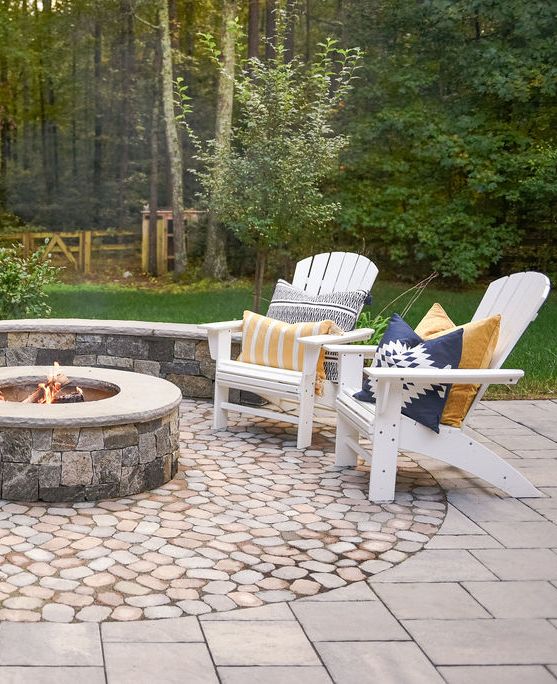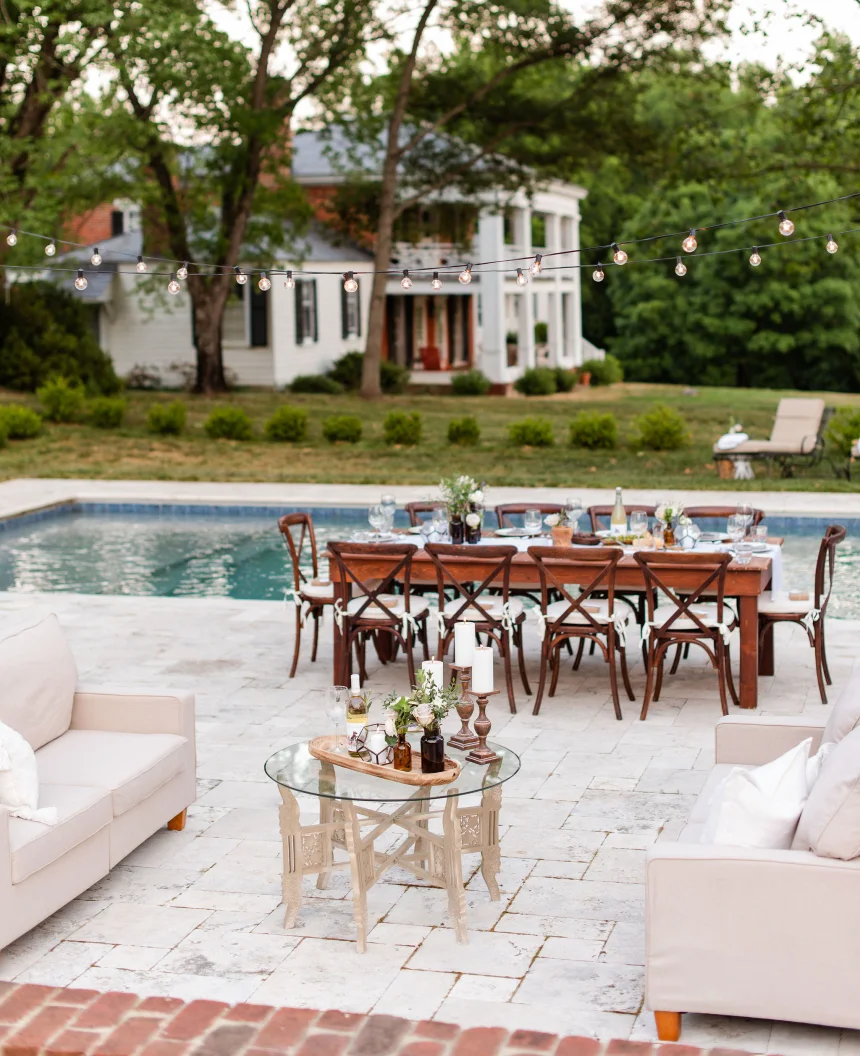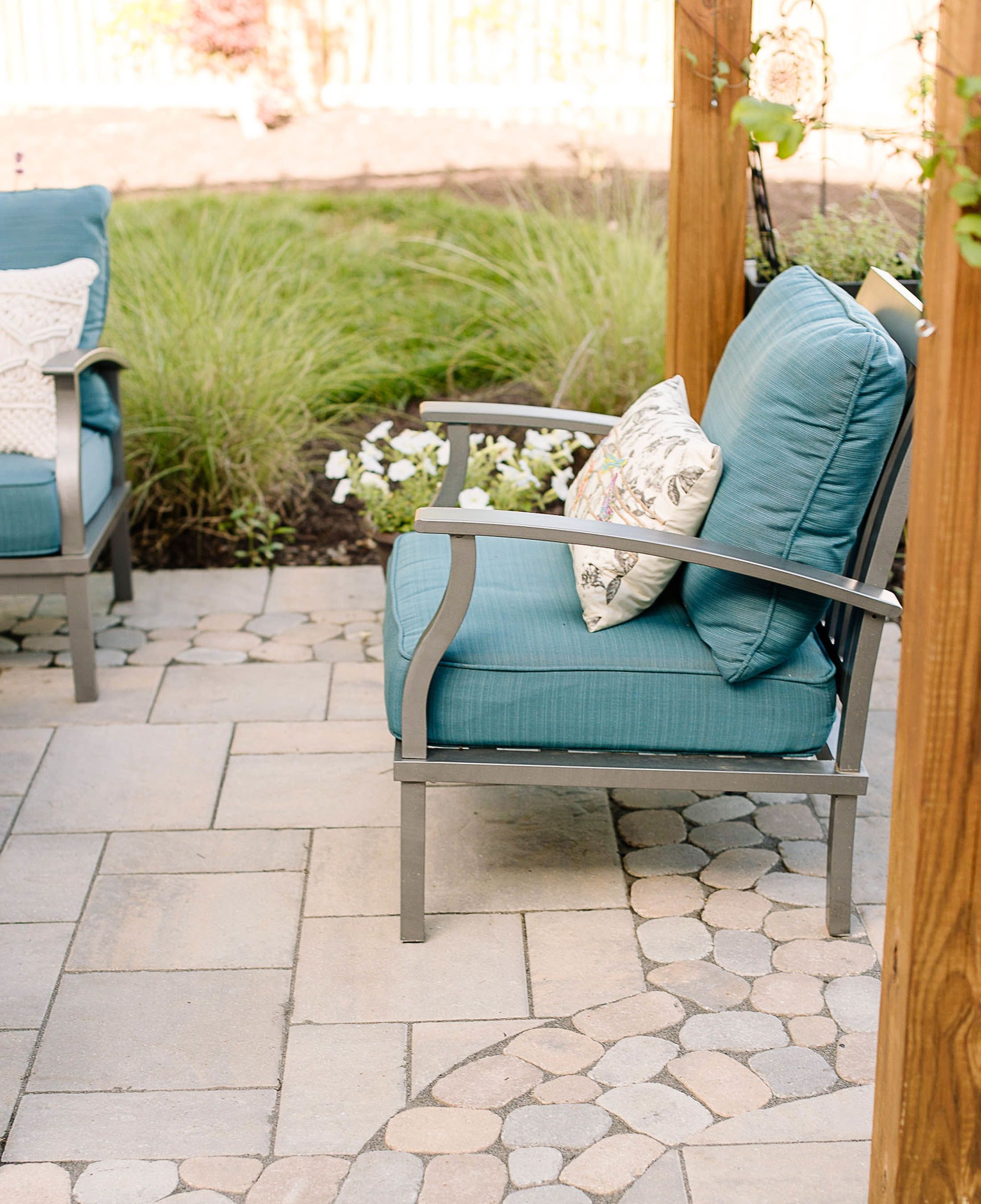Inspiration
A Guide to Selecting Materials for your Outdoor Living Space

Story Highlights
Selecting materials is one of the most important (and fun) aspects of planning an outdoor living space. Though most people make selections based on price and appearance, there are numerous additional factors to consider. Failure to thoroughly think through all of these factors can often lead to disappointment and regret.
In this guide, we discuss the numerous different factors that should be considered when selecting materials for an outdoor living space.

Consider the...
Use of the Space
When planning an outdoor living space, all decisions should start by considering the use of the space. Some examples include:
-
For areas with moving furniture, like dining chairs, it's important to use a flat, relatively smooth material that allows pieces to move freely and not wobble.
-
If you're going to be barefoot in the space, like around a pool, you'll want to consider how hot your materials get.
-
For walkways that won't get heavy foot traffic, it might be worth considering stepping stones to save money.
-
If your space will need to be cleared during winter weather, you'll want to consider materials that won't be damaged by snow shovels and de-icing salts.

Consider the...
Quality
The materials in your outdoor living space must withstand everything that Mother Nature can throw at it. Your outdoor living space needs to withstand the blazing sun, winter snow & ice, downpours of rain, as well as heavy winds that bring down branches and tree limbs. If you want your outdoor living space to provide long-term enjoyment and add value to your home, it's essential that you choose quality materials that will hold up over time. Whether it's higher maintenance requirements, eventual replacement costs, or the lower return on investment, selecting lesser-quality, low-price materials always costs more in the long term.

Consider the...
Maintenance
When selecting outdoor living materials, it's important to educate yourself on the maintenance requirements or each material being considered. Some materials, like wet cast pavers, have finishes that require sealants to retain their appearance. Other materials, like varieties of limestone, have a greater tendency for staining and require regular cleaning and sealing. Different materials also require various types of joint grouts, like mortar and polymeric sand, which have different maintenance requirements as well.
Consider the...
House
Designing an outdoor living space is much different than designing an indoor living space. Indoors rooms are confined by walls that allow you to do whatever you want inside the space, completely independent of other rooms and the overall architecture of the house. For example, you can have a transitional interior for a colonial home or a room dedicated to Asian/Zen culture in a house full of country interiors.
With outdoor living spaces, you don't have the same freedom because you're not in a visually confined space. When in an outdoor room, you cannot hide the house or the surrounding setting/neighborhood. Because of this, to create a cohesive look, it's important to consider the house and surrounding setting when selecting materials.

Consider the house...
Architecture
When adding an outdoor living space, it makes sense to select materials that match the architectural style of the home.
The pictured poolscape is a great example of this approach. To match the architecture of this 1700s home, we used travertine and handmade brick. Travertine has a naturally aged look and a long history as a building material, dating back to ancient Roman times. The handmade brick, used for retaining walls wrapping the space, provides a historic look that blends beautifully with the house.

Consider the House...
Color & Materials
Along with matching the architecture, it's equally important that your outdoor living materials match or compliment the color of your home.
In the pictured project, materials were chosen that both match and compliment the house. The main paver for this outdoor living space is variegated bluestone which beautifully compliments the all-brick home. The full-range color variegation of this bluestone offers auburn hues that match perfectly with the home's rose-colored brick. For additional cohesion, a simple inlay border of rose-colored brick pavers directly ties the house and outdoor living space together.

Beware of...
Trendy Materials
Some paver manufacturers design trendy products that can be very enticing. Many contractors even steer clients towards them in hopes of building a space that goes viral on social media. Though these materials can result in stunning spaces, trendy materials often look dated within a few years. Once a space becomes dated, the enjoyment is lowered as well as the return on investment. And unlike indoor rooms, which can be given a relatively inexpensive facelift, updating materials in an outdoor living space is difficult, expensive, and often requires complete rebuilding of structures.

Instead, the goal should be...
Timeless
Instead of chasing fleeting trends, aim for timeless with your materials and design. A timeless look will always be enticing, enjoyable, and provide a high return on investment. Whether your style is traditional, transitional, or modern, there are materials and designs that can provide a timeless look.

Consider
Borders & Inlays
Many homeowners choose to add interest and contrast with borders and inlays. As with trendy materials, be mindful when including these design flourishes. Though they can certainly be stunning and timeless, these accents can also become dated when trendy materials, color combinations, or designs are used.
The big debate
Stone vs. Concrete
One of the biggest decisions that homeowners often wrestle with is choosing between natural stone or concrete products. Whether it's pavers for a patio or veneer for walls and features, every type of building material for outdoor living spaces offers stone and concrete options. As outlined below, each material has its benefits and drawbacks.

Natural Stone Veneer
When it comes to appearance, it's difficult to beat the look and durability of natural stone. These options will hold up best to Mother Nature, resisting significant fading and finish degradation.
That said, some natural stone options are very expensive and color variations are limited by your region and what Mother Nature has created. Also, because it's a natural product, the stone that arrives for your project may be different than the stone you see in pictures or at the supplier.

Cast Veneer
Cast veneer is concrete that has been molded to resemble other building products, most often stone. Because it is a man-made product, the possibilities with cast veneer are endless and it's often much easier to find a style and color that you like. Additionally, because manufacturers create their color blends to pair nicely with building materials, it's rarely difficult to find a cast veneer product to match and/or complement a home.
Though it offers countless design and color options, cast veneer is not as durable as natural stone. Like all concrete products, the color and finish of cast veneer are susceptible to fading and wear if not sealed regularly. Additionally, chips and cut edges show the internal concrete aggregate, creating an artificial look.

Concrete Pavers
The rise in concrete paver popularity is the result of the wide variety of styles and color options available to consumers. As with cast veneer, concrete paver manufacturers color their products to blend seamlessly with exterior building materials used for home construction. With improved manufacturing techniques, many concrete pavers feature hyper-realistic textures that mimic natural stone and other surfaces. Additionally, concrete pavers provide greater opportunities for interesting borders, inlays, and color blends that can add a distinctive and artistic touch.
Though they offer a wide variety, most concrete pavers suffer from issues of fading and surface wear. Though structurally sound for a lifetime, the fading and surface wear negatively affect the look of the products. To prolong the original look of concrete pavers, homeowners must follow a regular sealant schedule.
Additionally, though once thought of as an "economic" option, concrete pavers from reputable manufacturers are just as expensive as natural stone. In some cases, like those with improved and pre-sealed finishes, concrete pavers are now more expensive than many natural stone options.

Natural Stone Pavers
For many, nothing can beat the look of natural stone pavers. The color variations, distinctive textures, and overall uniqueness of every piece represent a beauty that can only be achieved by time and nature. Though there are exceptions, natural stone pavers offer unbeatable durability as their colors and finishes withstand both heavy use and harsh weather.
Though natural stone pavers do offer variety, the selection and color choices are not as ample as with concrete pavers. Additionally, the natural colors of stone pavers are not always a perfect color match with the manufactured materials often used in home construction.
Unlike concrete pavers, which are manufactured uniformly, natural stone pavers have a greater variance in their measurements. Because of this, whether mortared or dry-laid, natural stone pavers require additional labor and skill to install. And, even when expertly installed by a skilled mason, the variances can result in uneven pavers. Additionally, when dry-laid, variances can also result in wabbling stones as settling occurs.
Relaxing Windsor Farms Retreat Project
Relaxing Windsor Farms Retreat Project
The design features numerous exciting elements including a pavilion-covered patio, gas fireplace, outdoor, water feature, stepping stone walkway, driveway with parking area, custom shed, and a new landscape that completes the relaxing and natural atmosphere. Without question, the resulting space is truly a full backyard transformation.